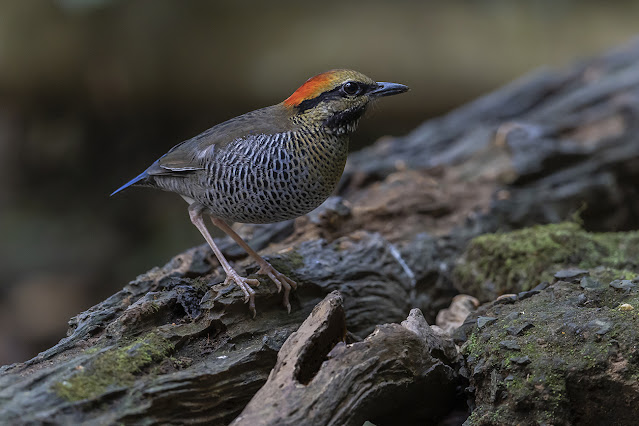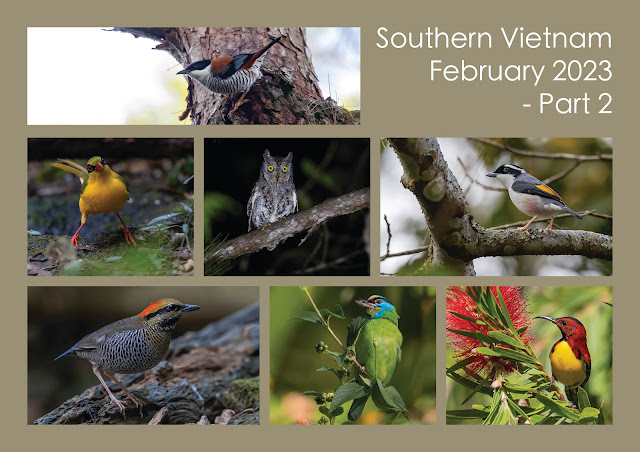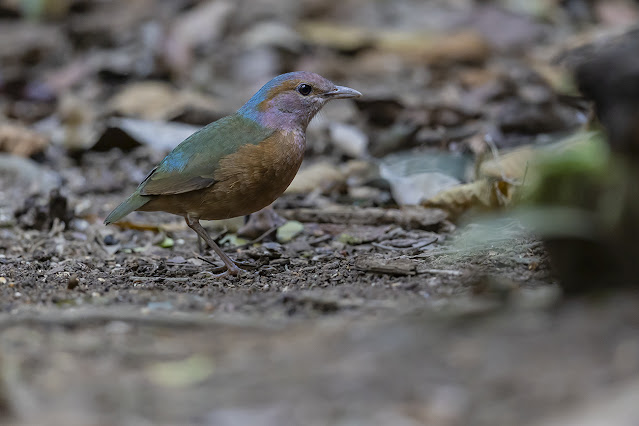Day - 4
On our second full day of Da Lat we once again started early. Our first birding spot was Ta Nung Valley, at a little ‘theme park’ call Hoa Son Dien Trang with lots of photo spot for tourists. Tien stated the area is quite good in the morning before the tourists arrives. And indeed it was really birdy! Ashy Drongos, Verditer Flycatchers were everywhere. Tien soon got our eyes on a few Indochinese Barbets and Black-throated Sunbird, the endemic subspecies johnsi is sometimes known as ‘Langbian Sunbird’.
 |
| Hoa Son Dien Trang |
 |
| Ashy Drongo |
 |
| Indochinese Barbet |
 |
| Black-throated Sunbird - race johnsi |
Black Bulbuls were seen perched on top of trees, race concolor is slightly lighter coloured than those we get in Hong Kong. Soon after we located a feeding flock, with birds such as Rufous-backed Sibia (race eximia) and other common species such as Blue-winged Minla and Mountain Fulvettas. A few Black-throated Tits were observed, the endemic subspecies annamensis is sometimes known as ‘Grey-crowned Tit’.
 |
| Black Bulbul |
 |
| Rufous-backed Sibia - race eximia |
 |
| Black-throated Tit - race annamensis |
Suddenly, Tien exclaimed “Grey-crowned Crocia!”, all of us rushed to his spot to scramble for a view, it took a while but soon everyone got their eyes on the bold flank streaks of the bird. This endemic species can sometimes be tricky to find, and even more difficult to get good photos as they like to move amongst small twigs of thick foliage trees. Luckily for us a few jumped to a small tree and we were able to get some good views.
 |
| Grey-crowned Crocia - One of our top target! |
After we bagged this major target we added a Bay Woodpecker which showed briefly. Other good birds included a Clicking Shrike-Babbler and a few White-browed Shrike-babblers, formerly split as an endemic species known as Dalat Shrike-Babbler, but recently lumped back together…The confusing times of birding by DNA! Either way they are great looking birds!
 |
| Bay Woodpecker |
 |
| Clicking Shrike-Babbler |
 |
| White-browed Shrike-Babbler - male & female, race annamensis |
Things dropped off slightly, but we added common species such as Sooty-headed Bulbul. A few Swinhoe’s White-eyes were feeding on the cherry blossoms. Hill Prinias were quite common here, a few came out for brief views. A female Fire-breasted Flowerpecker was seen.
 |
| Sooty-headed Bulbul |
 |
| Swinhoe's White-eye |
 |
| Hill Prinia |
 |
| Fire-breasted Flowerpecker - female |
Peter and Michelle found another Indochinese Barbet perched nicely on some lantana bush, while a male Vietnamese Greenfinch posed nicely under the morning sun. On our way back to the van we also added a male White-throated Rock Thrush, a Mugimaki Flycatcher, and a Grey-capped Pygmy Woodpecker. A Burmese Shrike also gave good views.
 |
| Indochinese Barbet |
 |
| Vietnamese Greenfinch - male |
 |
| White-throated Rock Thrush - male |
 |
| Mugimaki Flycatcher - female |
 |
| Grey-capped Pygmy Woodpecker - female |
 |
| Burmese Shrike |
Our second birding spot was a place call Datanla, an outdoor adventure theme-park. We stationed on the balcony at the restaurant there to wait for birds. Tien said someone seen the Vietnamese Cutia here recently, therefore we waited around hoping one will appear. Here we got good views of Streaked Spiderhunters and Mrs. Gould’s Sunbirds, race annamensis also sometimes known as Annam Sunbird have yellow breast.
 |
| Datanla |
 |
| Streaked Spiderhunter |
 |
| Mrs. Gould's Sunbird - female |
 |
| Mrs. Gould's Sunbird - male race annamensis |
We went around the back of the car park and found yet another good looking male White-throated Rock Thrush. Kloss's Leaf Warblers were very common here, but didn't mean they were easy to photograph. A pair of confiding Little Pied Flycatchers were added before lunch.
 |
| White-throated Rock Thrush - male |
 |
| Kloss's Leaf Warbler |
 |
| Little Pied Flycatcher - male & female |
After a relatively successful morning, we headed towards a mixed pine forest near Tuyen Lam Lake, where we continue our search for the Cutia! Here we added Eurasian Hoopoe, Green-billed Malkoha and Indochinese Cuckooshrike relatively quickly.
 |
| Eurasian Hoopoe |
 |
| Green-billed Malkoha |
 |
| Indochinese Cuckooshrike |
Things were quiet until we saw a Necklaced Barbet high up in the canopy, a new bird for most of us. We saw a few birds in a mixed flock and stop to observe, a few Ashy Bulbuls of race remotus were seen. Tien said he heard some Grey-crowned Crocias somewhere, sure enough I found a few feeding quite low down soon after!
 |
| Necklaced Barbet |
 |
| Ashy Bulbul - race remotus |
 |
| Grey-crowned Crocia |
The rest of the way down towards the lake was pretty quiet, some of us in the group were feeling unwell, presumably something we ate the previous day may have upset our stomachs. I was pretty much the only person within the group who felt fine. Half of us decided to head back to the hotel to rest for a few hours and skip the afternoon birding, while four of us stayed on. We didn’t see too much, except common birds such as Flavescent Bulbuls, Rufous-capped Babblers and Chestnut-vented Nuthatch. We rested on the ground using some old tires as pillows!
 |
| Flavescent Bulbul |
 |
| Rufous-capped Babbler |
 |
| Chestnut-vented Nuthatch |
The best bird in the afternoon were perhaps a few Yellow-billed Nuthatches, this species is not that common, and only found in Laos and Hainan Island outside of Vietnam. Another Collared Owlet was seen calling, while numerous Ashy Bulbuls hawked for insects in the open woodland. Kenneth spotted a Black Eagle drifting past, plus we added a very skittish Forest Wagtail along a forest trail.
 |
| Yellow-billed Nuthatch |
 |
| Collared Owlet |
 |
| Ashy Drongo |
 |
| Black Eagle |
 |
| Forest Wagtail |
Tien tried for Dalat Bush Warbler and Annam Prinia by the lake with little success. We met the other group at a cafe where we rested and waited till dark.Tien stated we will look for Oriental Scops Owls here, we walked no more than 50m when we saw a small bird flew out from the trees, and sure enough we got a pair of Oriental Scops Owl calling. Tien got us excellent views of one calling for the next 15 minutes. After getting some good photos we headed back to Da Lat for dinner, since most of us don’t have much appetite we ended up getting Pho for dinner, which was an excellent choice for the cool Da Lat evening.
 |
| Oriental Scops Owl |
 |
| Delicious Pho |
Day 5 -
This was our last morning at Da Lat, and our final chance to find the Vietnamese Cutia, which is our number one target bird of the trip. We headed back towards DT722 to bird along the roadside. Things started off fairly slowly, barely any birds were seen as we slowly walked along the road. We all felt anxious that we may dip on yet another major target.
Call of the Rufous-throated Partridges can be heard from down the slope. The first bird we saw were a few Black-throated Tits and Green-backed Tits, when suddenly Tien shouted “Cutia!”. We soon locked onto two rounded birds foraging on the tree trunks. The male with red mantle and a darker head with striped underside. The female with brown head, streaked mantle and more subdued colours.
 |
| Vietnamese Cutia - male |
 |
| Vietnamese Cutia - female |
With our main trip target seen, we felt extremely relieved! Since we got the target so early on, we got plenty of time to look for other birds under the glorious weather. Tien found us a Necklaced Barbet, this time in slightly better view. A few Eurasian Jays came through, the race leucotis is also known as the ‘White-faced Jay’.
 |
| Necklaced Barbet |
 |
| Eurasian Jay - race leucotis |
To our delight, Tien heard even more Vietnamese Cutias calling from down the slope! We scanned the trees and soon saw three foraging! There were two males and one female, one male was obviously courting and constantly chased after the female, while calling its unique whistle. The trio came even closer to us and gave phenomenal views. We watched them for nearly thirty minutes until they flew back down the slope and out of sight. All of us were overjoyed by this incredible experience and felt extremely fortunate that we had such a close encounter with this special endemic of the region.
 |
| Vietnamese Cutia - incredibly stunning bird! |
With time still to spare, Tien took us down closer to the reservoir where we tried for Dalat Bush Warblers and Annam Prinia, unfortunately none responded, but we got good views of a Little Cormorant, a pair of Vinous-breasted Mynas and a pair of Green-backed Tit. We went back to the hotel feeling extremely satisfied.
 |
| Little Cormorant |
 |
| Vinous-breasted Myna |
 |
| Green-backed Tit |
We packed our luggage and started our journey towards Di Linh, where we will stay for two nights. After lunch at Di Linh, we immediately headed towards the bird hide along Deo Nui San Pass, a forested country road that runs south from Di Linh, there were a lot of coffee plantations. Our main target here is the Blue Pitta, as well as the endemic Black-headed Parrotbill and hopefully even Bar-backed Partridges.
It was a quick walk up to the bird hide, where we soon settled down to wait for birds to arrive. Amongst the most common birds here are Greater Racket-tailed Drongo, Ochraceous Bulbul, Grey-eyed Bulbul and Orange-headed Thrush, of which two subspecies occurs here, including innotata and aurimacula.
 |
| Greater Racket-tailed Drongo |
 |
| Ochraceous Bulbul |
 |
| Grey-eyed Bulbul |
 |
| Orange-headed Thrush - race innotata |
 |
| Orange-headed Thrush - race aurimacula |
Another dominant species at this bird hide is the Hainan Blue Flycatcher, interesting thing is all of the birds we saw here were of race klossi, which apparently is more common at higher elevation than lower elevation. This subspecies was long considered part of the Blue-throated Flycatcher complex, but now placed with Hainan Blue Flycatchers, although they look very different from the usual Hainan Blues. Females are however almost indistinguishable.
 |
| Hainan Blue Flycatcher - male & female, race klossi |
Other wintering species here includes a pair of Mugimaki Flycatcher, a few Siberian Blue Robins and a single female White-throated Rock Thrush. Even an Alstrom's Warbler came through a few times.
 |
| Mugimaki Flycatcher |
 |
| Siberian Blue Robin |
 |
| White-throated Rock Thrush - female |
 |
| Alstrom's Warbler |
It didn’t take too long for the female Blue Pitta to show itself, even without the blue back it is still a stunning looking bird, with the fiery orange nape. Tien stated there’s not been a male that regularly visit the bird hides here recently.
 |
| Blue Pitta - female |
A male Blue-rumped Pitta also made an appearance, out of all the other males we saw on this trip, this one was probably the prettiest and most colourful, its face with a pinkish purple glow and a very bright blue nape and rump.
 |
| Blue-rumped Pitta - male |
Indochinese Green Magpie was another target species here, one showed up occasionally to the hide, race hypoleuca here with golden yellow underside looks very different to the south west China race we get in Hong Kong.
 |
| Indochinese Green Magpie - race hypoleuca |
By later afternoon, more birds came in to use the bird bath. White-bellied Erpornis, Grey-throated Babbler, Buff-breasted Babbler and Grey-headed Canary Flycatcher. We waited for the Black-headed Parrotbills and Silver-breasted Broadbills but they never came through.
 |
| White-bellied Erpornis |
 |
| Grey-throated Babbler |
 |
| Buff-breasted Babbler |
 |
| Grey-headed Canary Flycatcher |
We waited till dark in the bird hide, Tien said this hide is quite good for Mountain Scops Owl, indeed we heard quite a few as soon as it was dark. Tien tried calling one in, where we ended up seeing one above the hide and got some decent photos of this tiny owl. We had dinner at a little roadside cafe, Tien wanted to try one more time for Oriental Bay Owl along the road, however after nearly an hour of searching we got no response, only heard distant Grey Nightjars calling. We stayed at Thuy Duong Guesthouse, a small hotel that is simple but adequate for staying two nights.
 |
| Mountain Scops Owl |











































































































No comments:
Post a Comment